|
Tritium breeding blankets
Role of blankets
|
In a tokamak, the blanket is the object situated immediately behind the first wall (Cf figure opposite).
Simplified diagram of a fusion reactor. |
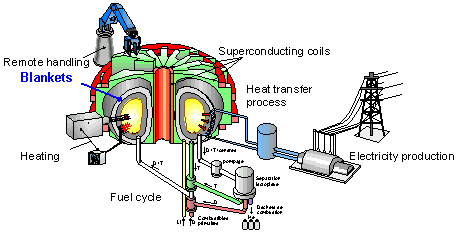
|
Its main functions are as follows :
-
Protect the magnets and the vacuum
vessel from neutron and gamma radiation.
-
Produce the tritium necessary for
continued fusion reactions.
-
Convert neutron energy into heat and evacuate it
to generate a cycle capable of supplying electricity.
These three functions may not be present at the same time (Cf chart below). In
the first phase of ITER operation, only the 1st function is guaranteed
(ie shield blanket). In
a second phase of ITER operation, the 1st and 2nd functions are guaranteed (ie cold tritium breeding blanket). In the case of a reactor, functions 1, 2 and 3 are required (ie tritium breeding blanket).
| |
Current machines |
ITER |
Reactor |
| 1 - Protection of magnets |
|
|
|
| 2 - Production of Tritium |
|
tests
|
|
| 3 - Converting neutron energy into heat |
|
|
|
function required
 |
The "Production of Tritium"
equation and notably reaching auto-sufficiency is a delicate balance.
Performance in terms of auto-sufficiency is characterised by the TBR (Tritium Breeding Ratio). A
TBR greater than 1 indicates that the blanket is auto-sufficiency.
|
The production of tritium is achieved through the reaction n + 6Li --> T + He. The lithium–based material may be in liquid (liquid metal like LiPb) or solid form (ceramic like Li4SiO4 or Li2ZrO3 or
Li2TiO3), i.e. liquid or solid tritium breeding blanket. For solid
blanket, auto-sufficiency necessitates use of a neutron multiplier like beryllium (for liquid
blanket, lead in the tritium breeding material acting as multiplier).
|

The fusion reaction
|
<-- PRODUCTION of tritium
|
In the case of inertial fusion, the functions of Protection, Production and Conversion are also required from the
blanket. The concepts developed for magnetic fusion are thus directly transferable to inertial fusion.
Activities of the EURATOM-CEA Association
Tritium breeding blankets are the subject of a specific European-level programme. Very significant results have been
obtained, such as, the demonstration that auto-sufficient production of tritium was achievable in a reactor. All the concepts developed to date have a TBR
greater than 1. Two concepts are being studied at the European level :
-
the WCLL concept (Water Cooled Litium Lead), developed under the
coordination of the CEA, uses a liquid metal (LiPb) as the tritium breeding material and water as
a coolant.
-
The HCPB concept (Helium Cooled Pebble Bed), developed under the
coordination of FZK
 , employs a tritium breeding material in solid form (lithiated ceramic) cooled by helium. , employs a tritium breeding material in solid form (lithiated ceramic) cooled by helium.
CEA tritium breeding blanket concept |
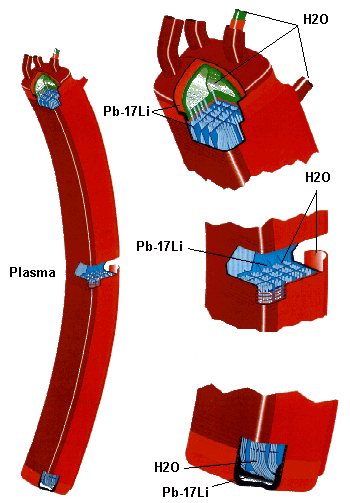
|
The main subjects of study of the Association are :
|
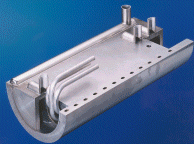
Model of test module manufactured
by hot isostatic pressure (HIP).
Manufacture of double tubes. |
 |
|
CEA loop enabling
the study of permeation barriers.
|
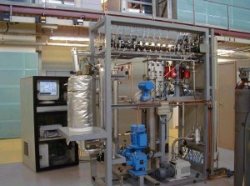
|
|
Semi-industrial manufacture of
tritium breeding ceramic pebble.
|
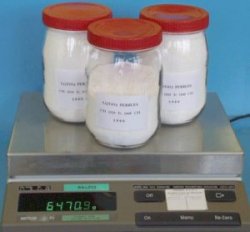
|
For further information :
- Fusion Technology. Annual Report of the Association
EURATOM/CEA
Blanket activitiesf
|
 1998 issue,
75p, 3577 ko, PDF
1998 issue,
75p, 3577 ko, PDF
 1999
issue, 90p, 3497 ko , PDF 1999
issue, 90p, 3497 ko , PDF
 2000
issue: 80p, 5259 ko, PDF 2000
issue: 80p, 5259 ko, PDF
 2001
issue: 93p, 6969 ko, PDF 2001
issue: 93p, 6969 ko, PDF
 2002
issue: 78p, 5964 ko, PDF 2002
issue: 78p, 5964 ko, PDF
 2003
issue: 48p, 14706 ko, PDF
2003
issue: 48p, 14706 ko, PDF
 2004 issue (PDF)
2004 issue (PDF)
- pages 000-014 :
Cover,
contents, introduction (518 Ko)
- pages 113-134 : EFDA
activities: breeding blanket (2 330 ko)
- pages 279-282 : Underlying
technologies: breeding blanket (2 663 ko)
 2005 issue (PDF)
2005 issue (PDF)
- pages 000-004 :
Cover,
contents, introduction (824 Ko)
- pages 161-220 :
EFDA
activities: breeding blanket 10 246 ko)
- pages 285-296 :
EFDA
activities: "Reactor" studies (720 ko)
- pages 367-370 :
Underlying
technologies: breeding blanket (2 663 ko)
 2006 issue (PDF)
2006 issue (PDF)
- pages 000-004 :
Cover,
contents, introduction (1.4 Mo)
- pages 145-211 :
EFDA
activities: breeding blanket (12.2 Mo)
- pages 271-280 :
EFDA
activities: "Reactor" studies (1.3 Mo)
- pages 360-361 :
Underlying
technologies: breeding blanket (0.5 Mo)
|
.
|
|